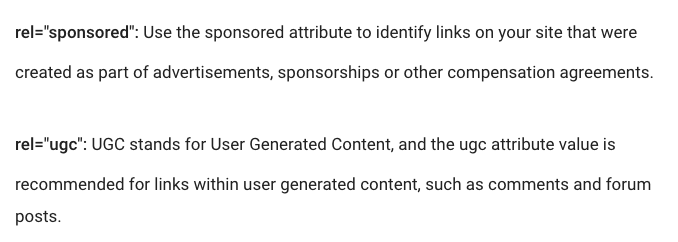Google’s new rel=“ugc” and “sponsored” shouldn’t change your strategy…but you can see if anyone else is using them
Google’s Gary Ilyes and Danny Sullivan recently announced an update to the way Google uses some links in search ranking – specifically links that include the “nofollow” attribute, launched in 2005 to help fight link spam.
Today, we’ve announced two new link attributes – “sponsored” and “ugc” – that join “nofollow” as ways to identify the nature of links. All will now work as hints about which links Google Search should consider or exclude for ranking purposes. More details:https://t.co/V6X2xjEC5L
— Google Webmasters (@googlewmc) September 10, 2019
Over time – especially after the Penguin update and spate of manual actions in 2012-13 – rel=“nofollow” became Google’s recommended way for site owners to highlight links they’d been paid to include.
The way “nofollow” previously worked is simple: when finding a link using the attribute, Googlebot wouldn’t enter the target website via that link. In theory, “nofollow” still works that way…except Googlebot might choose to ignore that request.
Many publishers have started to use rel=“nofollow”, not to mark up sponsored content, but to hoard PageRank, attempting to protect their own rankings. By mid-2019 this isn’t even a minority of publishing sites: most national and regional press prevent Google from crawling all external links from their sites.
This has caused huge problems for search engines: these are literally the sites breaking the news, making it all but impossible for Google to check their citations or find the original source of their stories. The “nofollow” attribute was meant to help Google discount bad links – in the end it’s prevented the search engine from using good ones. So when Google announces that it’s giving more prominence to the original source of stories just as it’s able to follow external links from news sites to the original sources that probably isn’t a coincidence.
Unlike previous updates to how Google handles links (such as the original “nofollow” announcement), this doesn’t change how links are built for most SEOs…apart from those not already building links on the biggest and most authoritative news websites, which has been the norm for a few years now. It does change the conversations around KPIs we’re having with our clients: it’s no longer necessary for our campaigns to deliver a certain number or percentage of “followed” links since, where the sites are clearly good (like national and regional press), they count.
Google most likely worded this carefully – nofollow is now a hint for ranking. Was it strictly followed yesterday? They don’t say no, so we can assume it’s been a “hint” for a while. https://t.co/JGUzWCqyw7
— Jared McKiernan (@jaredmckiernan) September 10, 2019
Many SEOs have stated publicly that Google has attributed value through “nofollow” links for at least a few months. So, from a link building point of view, this shouldn’t change any aspect of your strategy (unless you weren’t building links, in which case you probably should).
…and from a privacy point of view: if you’re concerned about passing information to Google via the links you’re pointing to external websites, you can still use the “noreferrer” attribute to hide most of your info from Google Analytics and so on.
Internal links using the “nofollow” attribute
The “nofollow” attribute is also widely used in internal linking as we attempt to prevent Googlebot from crawling faceted navigation/filtering options on ecommerce websites, for example. Although best practice would have these pages include canonical attributes to prevent them getting indexed, the “nofollow” attribute would be applied to internal links pointing to the page to prevent Googlebot from crawling them in the first pace.
In my opinion, this is the biggest change coming out of the announcement (and the only one that should significantly affect most SEOs): we now have to use robots.txt to disallow the crawling of session IDs, facets etc. – we just can’t rely on internal “nofollow” if it’s going to be a “hint” rather than an order.
rel=“ugc” and rel=“sponsored”
Also announced were two new attributes with a similar function to the original intention of “nofollow”.

Danny Sullivan has stressed (in an admirable number of tweets) that changing “nofollow” attributes to “ugc” or “sponsored” is not mandatory. You’d do it using a blanket implementation if you have a forum, or add it to the comments section if you have a publishing website (most websites that aren’t news publishers probably shouldn’t have a comments section in 2019).
We really did think carefully about our blog post on the change to nofollow and new attributes, including making it really clear that people don’t have to change anything and that our view of such links as a strong indicator they shouldn’t be used for credit will continue….. pic.twitter.com/iFbqqzfOMW
— Danny Sullivan (@dannysullivan) September 11, 2019
My assumption is that, because Danny is stressing it’s not all that important if you do it, Google feels pretty confident it can discount or devalue all of these links anyway.
So this really shouldn’t change your strategy at all: link-focused SEOs are the most concerned about these announcements – when really it’s a positive for them, and extra work for developers in some cases.
If your website regularly publishes news or hosts a forum, you might look at implementing these new attributes, in which case SEOBUDDY’s Backlink Analysis section already supports the new attributes and you can track their success easily. It’s particularly useful from a data visualization point of view so you can easily see what percentage of your profile is being affected.

